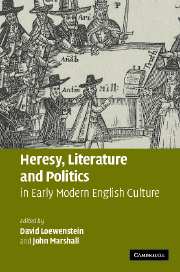Book contents
- Frontmatter
- Contents
- Acknowledgments
- Notes on contributors
- Introduction
- 1 Writing and the persecution of heretics in Henry VIII's England: The Examinations of Anne Askew
- 2 Anabaptism and anti-Anabaptism in the early English Reformation: defining Protestant heresy and orthodoxy during the reign of Edward VI
- 3 “Godlie matrons” and “loose-bodied dames”: heresy and gender in the Family of Love
- 4 Puritanism, Familism, and heresy in early Stuart England: the case of John Etherington revisited
- 5 A ticklish business: defining heresy and orthodoxy in the Puritan revolution
- 6 Thomas Edwards's Gangraena and heresiological traditions
- 7 “And if God was one of us”: Paul Best, John Biddle, and anti-Trinitarian heresy in seventeenth-century England
- 8 The road to George Hill: the heretical dynamic of Winstanley's early prose
- 9 Milton and the heretical priesthood of Christ
- 10 An Historical Narration Concerning Heresie: Thomas Hobbes, Thomas Barlow, and the Restoration debate over “heresy”
- 11 Defining and redefining heresy up to Locke's Letters Concerning Toleration
- 12 “Take heed of being too forward in imposinge on others”: orthodoxy and heresy in the Baxterian tradition
- Index
4 - Puritanism, Familism, and heresy in early Stuart England: the case of John Etherington revisited
Published online by Cambridge University Press: 20 February 2010
- Frontmatter
- Contents
- Acknowledgments
- Notes on contributors
- Introduction
- 1 Writing and the persecution of heretics in Henry VIII's England: The Examinations of Anne Askew
- 2 Anabaptism and anti-Anabaptism in the early English Reformation: defining Protestant heresy and orthodoxy during the reign of Edward VI
- 3 “Godlie matrons” and “loose-bodied dames”: heresy and gender in the Family of Love
- 4 Puritanism, Familism, and heresy in early Stuart England: the case of John Etherington revisited
- 5 A ticklish business: defining heresy and orthodoxy in the Puritan revolution
- 6 Thomas Edwards's Gangraena and heresiological traditions
- 7 “And if God was one of us”: Paul Best, John Biddle, and anti-Trinitarian heresy in seventeenth-century England
- 8 The road to George Hill: the heretical dynamic of Winstanley's early prose
- 9 Milton and the heretical priesthood of Christ
- 10 An Historical Narration Concerning Heresie: Thomas Hobbes, Thomas Barlow, and the Restoration debate over “heresy”
- 11 Defining and redefining heresy up to Locke's Letters Concerning Toleration
- 12 “Take heed of being too forward in imposinge on others”: orthodoxy and heresy in the Baxterian tradition
- Index
Summary
In order to make heresy or heretics, you need at least two things: a belief or idea available to be labeled as “heresy,” and a body of other ideas whose status as “orthodoxy” is threatened by that idea and/or established or confirmed through that labeling process. Of course, the existence of the belief or idea also implies the existence of persons or a group to originate or propagate or perhaps merely to believe in it. “Orthodoxy” similarly implies the existence of other persons wishing to protect and enforce their beliefs as “orthodox.” To successfully create “heresy” is in fact to create “orthodoxy,” and successfully to label and punish someone as a heretic or to proscribe ideas labeled heretical is also to create or to mobilize claims to, and structures of, authority.
To talk about the relationship of English Puritanism to such processes is, of course, to open a can of worms. During the Elizabethan and early Stuart periods, the relationship between Puritanism and the structures of authority in England that defined and enforced “conformity” and “orthodoxy” (and therefore made heresy) was notoriously ambivalent and complex. Indeed, one might argue that Puritanism was that ambivalent and complex relationship between a certain strand of reformed Protestantism and what came to be regarded as “authority” in the English church and state after the Reformation.
- Type
- Chapter
- Information
- Publisher: Cambridge University PressPrint publication year: 2006
- 1
- Cited by



